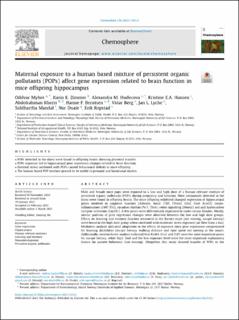Maternal exposure to a human based mixture of persistent organic pollutants (POPs) affect gene expression related to brain function in mice offspring hippocampus
| dc.contributor.author | Myhre, Oddvar | |
| dc.contributor.author | Zimmer, Karin Elisabeth | |
| dc.contributor.author | Hudecova, Alexandra Misci | |
| dc.contributor.author | Hansen, Kristine Eraker Aasland | |
| dc.contributor.author | Khezri, Abdolrahman | |
| dc.contributor.author | Berntsen, Hanne Friis | |
| dc.contributor.author | Berg, Vidar | |
| dc.contributor.author | Lyche, Jan Ludvig | |
| dc.contributor.author | Mandal, Siddhartha | |
| dc.contributor.author | Duale, Nur | |
| dc.contributor.author | Ropstad, Erik | |
| dc.date.accessioned | 2021-06-04T06:03:44Z | |
| dc.date.available | 2021-06-04T06:03:44Z | |
| dc.date.created | 2021-03-22T13:46:02Z | |
| dc.date.issued | 2021 | |
| dc.identifier.issn | 0045-6535 | |
| dc.identifier.uri | https://hdl.handle.net/11250/2757602 | |
| dc.description.abstract | Male and female mice pups were exposed to a low and high dose of a human relevant mixture of persistent organic pollutants (POPs) during pregnancy and lactation. Most compounds detected in the dams were found in offspring brains. The mice offspring exhibited changed expression of hippocampal genes involved in cognitive function (Adora2a, Auts2, Crlf1, Chrnb2, Gdnf, Gnal, Kcnh3), neuroinflammation (Cd47, Il1a), circadian rhythm (Per1, Clock), redox signalling (Hmox2) and aryl hydrocarbon receptor activation (Cyp1b1). A few genes were differentially expressed in males versus females. Mostly, similar patterns of gene expression changes were observed between the low and high dose groups. Effects on learning and memory function measured in the Barnes maze (not moving, escape latency) were found in the high dose group when combined with moderate stress exposure (air flow from a fan). Mediation analysis indicated adaptation to the effects of exposure since gene expression compensated for learning disabilities (escape latency, walking distance and time spent not moving in the maze). Additionally, random forest analysis indicated that Kcnh3, Gnal, and Crlf1 were the most important genes for escape latency, while Hip1, Gnal and the low exposure level were the most important explanatory factors for passive behaviour (not moving). Altogether, this study showed transfer of POPs to the offspring brains after maternal exposure, modulating the expression level of genes involved in brain function. | |
| dc.language.iso | eng | |
| dc.title | Maternal exposure to a human based mixture of persistent organic pollutants (POPs) affect gene expression related to brain function in mice offspring hippocampus | |
| dc.type | Peer reviewed | |
| dc.type | Journal article | |
| dc.description.version | publishedVersion | |
| dc.source.volume | 276 | |
| dc.source.journal | Chemosphere | |
| dc.identifier.doi | 10.1016/j.chemosphere.2021.130123 | |
| dc.identifier.cristin | 1899918 | |
| dc.relation.project | Norges forskningsråd: 204361 | |
| dc.relation.project | Norges forskningsråd: 213076 | |
| cristin.ispublished | true | |
| cristin.fulltext | original | |
| cristin.qualitycode | 1 |
Tilhørende fil(er)
Denne innførselen finnes i følgende samling(er)
-
Artikler [5061]
-
Publikasjoner fra CRIStin FHI [7536]
